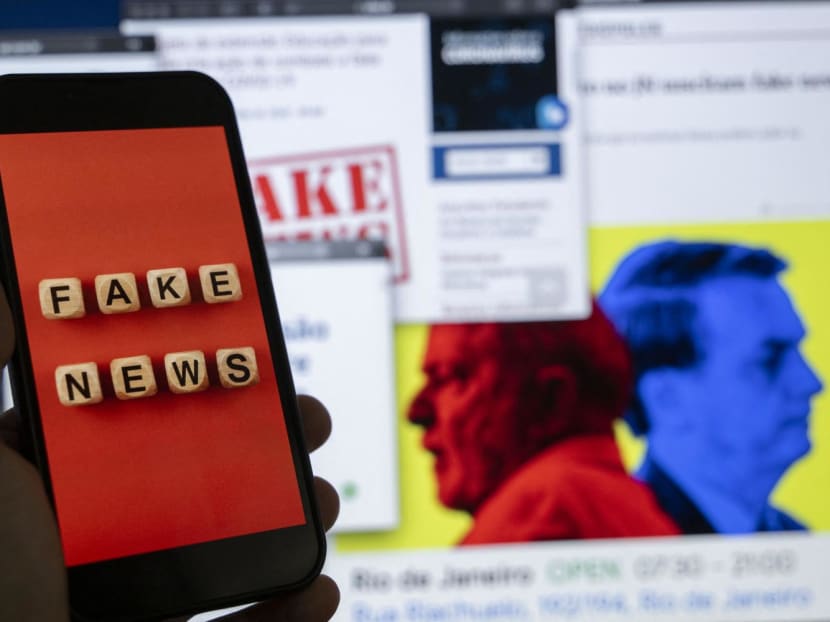Commentary: How to 'vaccinate' youth against believing fake news
In March 2022, anonymous TikTok accounts and commenters on social media posts pertaining to the Russian invasion of Ukraine gave the false impression that there were many in Singapore who were pro-Russia in their support of the invasion and could have a persuasive impact on Singaporeans.

While it may be difficult to go against the operation of our cognitive biases that make us believe or spread disinformation, effective education against fake news could serve an inoculating effect that checks the operation of our cognitive biases, say the authors.
In March 2022, anonymous TikTok accounts and commenters on social media posts pertaining to the Russian invasion of Ukraine gave the false impression that there were many in Singapore who were pro-Russia in their support of the invasion and could have a persuasive impact on Singaporeans.
In February 2023, a ChatGPT-generated fake news about Hangzhou’s lifting of number plate-based driving restrictions went viral because a user found ChatGPT’s response entertaining.
Disinformation, or the intentional communication of false information to achieve some goal, has appeared in many guises throughout history. It has been known as gossip, propaganda, rumour, and lately, fake news.
We have witnessed its pernicious effects in anti-vaccination messaging, climate change denial and possibly on election results.
But we can gradually sensitise large segments of our population about fake news and train them to counter its influence through effective fake news education in schools.
In this article, we will look at some research-backed fake news education methods. But first, let us examine three methods that research gives us reason to hesitate in implementing.
WHY SOME ANTI-FAKE NEWS METHODS MAY NOT WORK
The first is retractions and corrections of disinformation. When the false content is repeated in retracting or correcting it, its audience is exposed to the false content again.
Repeated exposure to content that we are unsure of has been shown to increase its believability to us.
Hence, a retraction or a correction that contains a reiteration of the false information, particularly if it is not accompanied by an explanation of why it is false, could cause us to believe the information even more.
The final word on retractions or corrections has not been spoken. Some experts say that the pernicious effect is minimal while a study post-dating the expert views continues to show its perniciousness.
Second, when fake news causes us to believe or spread it, it is often because we do not carefully consider whether the information is true, or what the consequences of spreading it are.
Instead, some mental tendency is triggered that leads us to automatically believe or spread the information.
This mental tendency is a cognitive bias. Cognitive biases help us to process information efficiently, but also can serve to lead us to wrongly believe or spread information.
Research on some anti-bias training in the racial context has shown that it either does not result in less bias or does not have lasting results in reducing bias.
Third, analytical thinking or critical thinking — the type of thinking that carefully evaluates the quality of information — has often been thought to be opposed to the automatic responses to fake news that the triggering of our cognitive biases create.
However, a fake news training curriculum that relies solely on training analytical or critical thinking competencies could backfire in producing expert fake news creators who create extremely convincing or viral fake news because they are proficient at exploiting their audience’s cognitive biases and vulnerability to fallacious reasoning.
THE BETTER WAY TO TACKLE FAKE NEWS
What we require, then, is some form of fake news training whose efficacy is backed by research.
Accuracy prompts are reminders, before exposure to a piece of disinformation, for a reader or audience to be careful about the accuracy of the information.
Games like Bad News, Harmony Square and Cranky Uncle introduce people to the intentions and mechanisms behind the generation of fake news.
They are free of charge and can be played in a web browser. The efficacies of these games have been the objects of many empirical studies with positive results.
Misconception-based learning involves the teaching of scientific knowledge by having students research and present why certain ideas are scientifically false.
Accuracy prompts, games and misconception-based learning are forms of inoculation.
Inoculation in disinformation education, just as in the case of vaccination in medicine, builds up immunity by exposing people to weakened doses of the infectious agent before they are exposed to the actual thing.
In this case, the infectious agent is fake news and the immunity is immunity to believing or spreading it.
In conclusion, here are three ideas on which one can build a fake news lesson based on inoculation.
First, use active disinformation inoculating games as starter activities for fake news lessons.
Second, give students a sensational news article and ask them to identify clues that it may be fake news.
Then reveal the evidence that it is actually real news. This method familiarises students with indicators of fake news as well as teaches them intellectual humility about their conclusions.
Third, there are many fake news checklists on the internet. These contain items that could serve to flag information as suspicious.
Instead of applying a fake news checklist to suspicious information, have students critique a fake news checklist by imagining what sort of false information it would fail to flag as suspicious.
While it may be difficult to go against the operation of our cognitive biases that make us believe or spread disinformation, effective education against fake news could serve an inoculating effect that checks the operation of our cognitive biases.
ABOUT THE AUTHORS:
Adrian Kwek is Associate Professor, Centre for Interdisciplinary and Experiential Learning (Core Learning) at Singapore University of Social Sciences; and Josef Tan is Lead Specialist (Geography), Curriculum Planning and Development Division, Ministry of Education.









